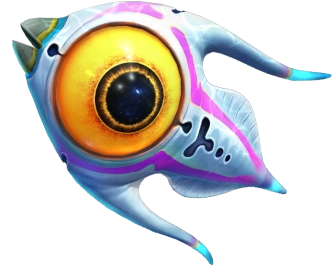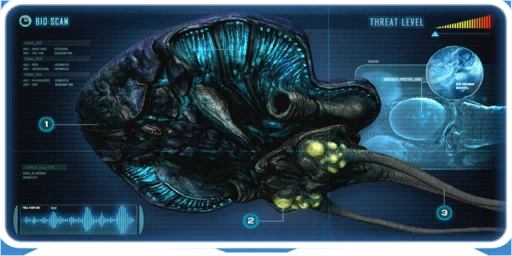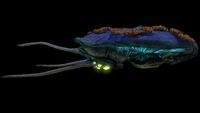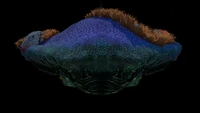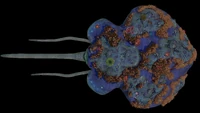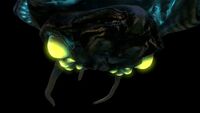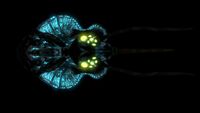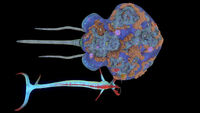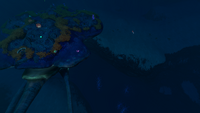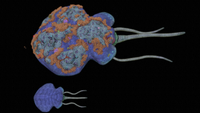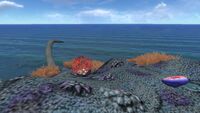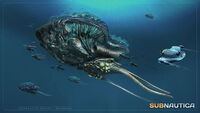The Reefback Leviathan is a passive leviathan class fauna species. It is the third largest passive life form.
Appearance[]
The Reefback is massive in size, with most of the creature's body being comprised of a thick, dark-blue carapace with a rounded, triangular front, and a relatively small body concentrated in the posterior. Attached to its main body are three long whip-like tentacles.
An adult Reefback has patches of teal-colored coral and brown-colored grass growing across its carapace, befitting its name, while the younger ones lack this trait. The carapace has a slightly bright blue dotted pattern across towards the back. Beneath its carapace, it is dark green with light blue bioluminescent stripes on the sides and in the middle. On either side of its body are eight yellow bioluminescent bulbs. The purpose of these is unknown, though the data bank entry notes a visual similarity to the Gasopod algae gland. Although they could be the Leviathan's eyes, it remains unclear as the PDA states they serve an unknown function in the digestive system. Two siphon-esque structures that constantly expand and retract as the creature moves are located next to these bulbs.
In the back of the Reefback, there are giant tubes. These seem to be where the calls of the Reefback come from.
Behavior[]
The Reefback drifts slowly and gently around the open waters of many biomes, mostly seen swimming in pods of more than two. It rarely adjusts its current altitude, unless bumped against obstacles.
Juvenile Reefbacks are a quarter the size of an adult. They can often be found with adults in certain locations.
The Reefback will frequently emit a range of echoing, low-frequency calls. They will only emit these calls if there are other Reefbacks nearby. This suggests that these calls are a form of communication, as opposed to echolocation.
When Reefbacks are exposed to damage, their tentacles will wave quickly and they will move slightly faster for a brief period. When killed, their models and hitboxes completely disappear however the flora on their backs stay and fall towards the sea floor.
Mini-ecosystem[]
Adult Reefbacks can support mini-ecosystems on their back. These ecosystems include many types of flora and coral, along with other small fauna swimming in the vicinity of the gentle giants. Some caution should be taken when approaching Reefbacks, as Tiger Plants often make their homes on their backs. Adult Reefbacks often have barnacles growing on their back. These barnacles are Harvesting Nodes and can be broken to reveal resources, similar to limestone, shale, or sandstone outcrops. Currently, they only drop two resources: Silver Ore and Copper Ore. Copper ore is the most frequent resource to find.
Energy Value[]
Data Bank Entry[]
|
This vast lifeform is in excess of 30m long and has been designated leviathan class. Fortunately it feeds exclusively on plankton-like lifeforms in the water. 1. Chitinous Shell: 2. Enzyme Pods: 3. Local Microcosm: 4. Lifecycle: Assessment: Harbors plants, small fish and metal-rich barnacles |
Gallery[]
Trivia[]
- Bladderfish and Holefish Schools can only be found near Reefbacks and do not naturally spawn anywhere else.
- Reefbacks are capable of transporting the player when near the surface.
- While this may provide safety from nearby predators, it would be much faster to just swim manually underwater.
- Juveniles can be found infected with Kharaa, whereas the adults cannot.
- Reefbacks were initially intended to submerge themselves in sandy areas. Increased activity around them would have made them rise in search of a peaceful place to rest.[1]
- Another intended interaction would've been that the player could grab hold of a Reefback's tentacles to hitch a ride or hide on their plant-covered backs to hide from predators.[2]
- Reefbacks were formerly much smaller than they currently are, and had the same texture that is currently given to juvenile Reefbacks.
- The game refers to Reefbacks as herbivores, yet the data bank entry states that they are planktivorous.
- The underside of a Reefback greatly resembles that of the Combine Gunship from the game Half Life 2.
- Reefbacks can travel at 0.5 meters per second.
- Reefbacks are the only animals that don't have a death animation.
- Reefbacks previously used to be able to make bubbling noises in the earlier versions. It's unknown why these were removed.
References[]
Glitches[]
- Reefbacks can ocassionally wander into the Safe Shallows.
| Fauna living within the Crater | |
|---|---|
| Carnivores | |
| Herbivores | |
| Scavengers & Parasites | |
| Leviathans | |
| Extinct | |
| Other Entities | |
